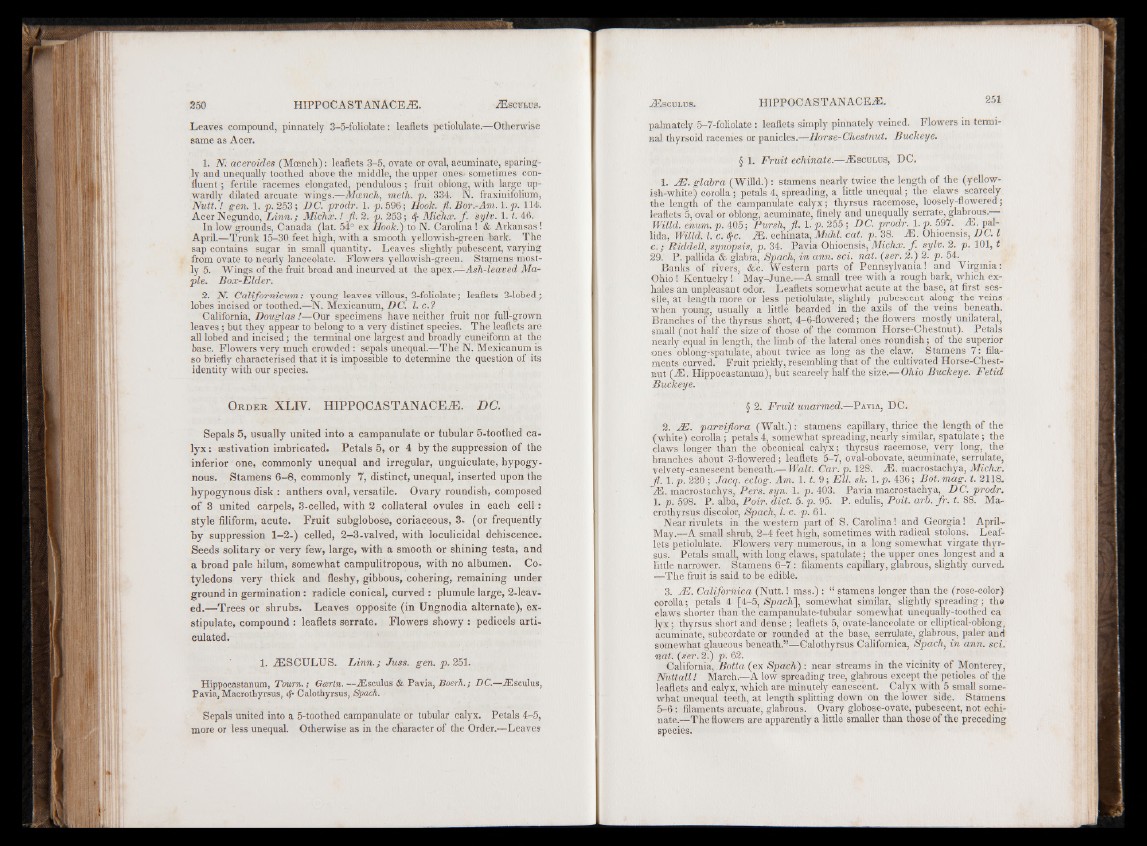
Leaves compound, pinnately 3-5-foliolate: leaflets petiolulate.—Otherwise
same as Acer.
1. N: aceroides (Moench): leaflets 3-5, ovate or oval, acuminate, sparingly
and unequally toothed above the middle, the upper ones* sometimes confluent
; fertile racemes elongated, pendulous; fruit oblong, with large upwardly
dilated arcuate wings.—Moench, meth. p. 334. N. fraxinifolium,
Nutt. ! gen. 1. p. 253; DC. prodr. 1. p. 596; Hook. Jl. Bor.-Am. 1. p. 114.
Acer Negundo, Linn.; Michx.! Jl. 2. p. 253; Michx. ƒ. sylv. 1 .1. 46.
In low grounds, Canada (lat. 54° ex Hook.) to N. Carolina ! & Arkansas!
April.—Trunk 15-30 feet high, with a smooth yellowish-green hark. The
sap contains sugar in small quantity. Leaves slightly pubescent, varying
from ovate to nearly lanceolate. Flowers yellowish-green. Stapnens mostly
5. Wings of the fruit broad and incurved at the apex.—Ash-leaved Maple.
Box-Elder.
2. N. Californicum: young leaves villous, 3-foliolate; leaflets 3-lobed ;
lobes incised or toothed.—N. Mexicanum, DC. 1. c.?
California, Douglas!—Our specimens have neither fruit nor full-grown
leaves; hut they appear to belong to a very distinct species. The leaflets are
all lobed and incised; the terminal one largest and broadly cuneiform at the
base. Flowers very much crowded : sepals unequal.—The N. Mexicanum is
so briefly characterised that it is impossible to determine the question of its
identity with our species.
Or d e r XLIY. HIPPOCASTANACEiE. DC.
Sepals 5, usually united into a campanulate or tubular 5-toothed calyx
: aestivation imbricated. Petals 5, or 4 by the suppression of the
inferior one, commonly unequal and irregular, unguiculate, hypogy-
nous. Stamens 6-6, commonly 7, distinct, unequal, inserted upon the
hypogynous disk : anthers oval, versatile. Ovary roundish, composed
of 3 united carpels, 3-celled, with 2 collateral ovules in each c e ll:
style filiform, acute. Fruit subglobose, coriaceous, 3- (or frequently
by suppression 1-2-) celled, 2-3-valved, with loculicidal dehiscence.
Seeds solitary or very few, large, with a smooth or shining testa, and
a broad pale hilum, somewhat campulitropous, with no albumen. Cotyledons
very thick and fleshy, gibbous, cohering, remaining under
ground in germination : radicle conical, curved : plumule large, 2-leaved.—
Trees or shrubs. Leaves opposite (in Ungnodia alternate), ex-
stipulate, compound : leaflets serrate. Flowers showy : pedicels a rticulated.
1. iESCULUS. L in n .; Juss. gen. p. 251.
Hippocastanum, Town.; Gcertn.—JEsculus & Pavia, Boerh.; DC.—ADsculus,
Pavia, Macrotliyrsus, <ĥ Calothyrsus, Spach.
Sepals united into a 5-toothed campanulate or tubular calyx. Petals 4-5,
more or less unequal Otherwise as in the character of the Order.—Leaves
palmately 5-7-foliolate : leaflets simply pinnately veined. Flowers in terminal
thyrsoid racemes or panicles.—Horse-Chestnut. Buckeye.
§ 1. Fruit echinate.—ADsculus, DC.
1. JE. glabra (Willd.) : stamens nearly twice the length of the (yellowish
white) corolla; petals 4, spreading, a little unequal; the claws scarcely
the length of the campanulate calyx; thyrsus racemose, loosely-flowered;
leaflets 5, oval or oblong, acuminate, finely and unequally serrate, glabrous.
Willd. enum. p. 405; Pursh, fl. 1. p. 255; DC. prodr. l.p . 597. AH. pallida,
Willd. 1. c. Jf-c. AE. echmata, Muhl. cat. p. 38. M. Ohioensis, DC. I
c .; Riddell, synopsis, p. 34. Pavia Ohioensis, Michx. f . sylv. 2. p. 101, t
29. P. pallida & glabra, Spach, in ann. sci. nat. (ser.2.) 2. p. 54.
Banks of rivers, &c. Western parts of Pennsylvania! and Virginia:
Ohio ! Kentucky ! May-June.—A small tree with a rough bark, which exhales
an unpleasan t odor. Leaflets somewhat acute at the base, at first sessile,
at length more or less petiolulate, slightly pubescent along the veins
when young, usually a little bearded in the axils of the veins beneath.
Branches of the thyrsus short, 4r-6-flowered; the flowers mostly unilateral,
small (not half the size'of those of the common Horse-Chestnut). Petals
nearly equal in length, the limb of the lateral ones roundish; of the superior
ones oblong-spatulate, about twice as long as the claw. Stamens 7: filaments
curved. Fruit prickly, resembling that of the cultivated Horse-Chestnut
(AD. Hippocastanum), but scarcely half the size.— Ohio Buckeye. Fetid
Buckeye.
§ 2. Fruit unarmed.—P avia, DC.
2. JE. parvijlora (Walt.) : stamens capillary, thrice the length of the
(white) corolla; petals 4, somewhat spreading, nearly similar, spatulate; the
claws longer than the obconical calyx; thyrsus racemose, very long, the
branches about 3-flowered; leaflets 5—7, oval-obovate, acuminate, serrulate,
velvety-canescent beneath.— Walt. Car. p. 128. AD. macrostachya, Michx.
f .. l.p . 220 ; Jacq. eclog. Am. l .t .9 ; Ell. sk. l.p . 436; Bot.mag. t. 2118.
AD. macrostaehys, Peis. syn. 1. p. 403. Pavia macrostachya, DC. prodr.
1. p. 598. P. alba, Pair. diet. 5. p. 95. P. edulis, Poit. arb. fr . t. 88. Macrothyrsus
discolor, Spach, l. c. p. 61.
Near rivulets in the western part of S. Carolina! and Georgia! April-
May.—A small shrub, 2-4 feet high, sometimes with radical stolons. Leaflets
petiolulate. Flowers very numerous, in a long somewhat virgate thyrsus.
Petals small, with long claws,- spatulate ; the upper ones longest and a
little narrower. Stamens 6-7 : filaments capillary, glabrous, slightly curved.
—The fruit is said to be edible.
3. JE. Californica (Nutt.! mss.) : “ stamens longer than the (rose-color)
corolla; petals 4 [4-5, SpacK], somewhat similar, slightly spreading; the
claws shorter than the campanulate-tubular somewhat unequally-toothed ca
ly x ; thyrsus short and dense; leaflets 5, ovate-lanceolate or elliptical-oblong,
acuminate, subcordate or rounded at the base, serrulate, glabrous, paler and
somewhat glaucous beneath.”—Calothyfsus Californica, Spach, in ann. sci.
nat. (ser.2.) p. 62. 1 1 : - . . . [ ' '
California, Botta (ex Spach) : near streams in the vicinity of Monterey,
Nuttall! March.—A low spreading tree, glabrous except the petioles of the
leaflets and calyx, which are minutely canescent. Calyx with 5 small somewhat
unequal teeth, at length splitting down on the lower side. Stamens
5-6 : filaments arcuate, glabrous. Ovary globose-ovate, pubescent, not echinate.—
The flowers are apparently a little smaller than those of the preceding
species.